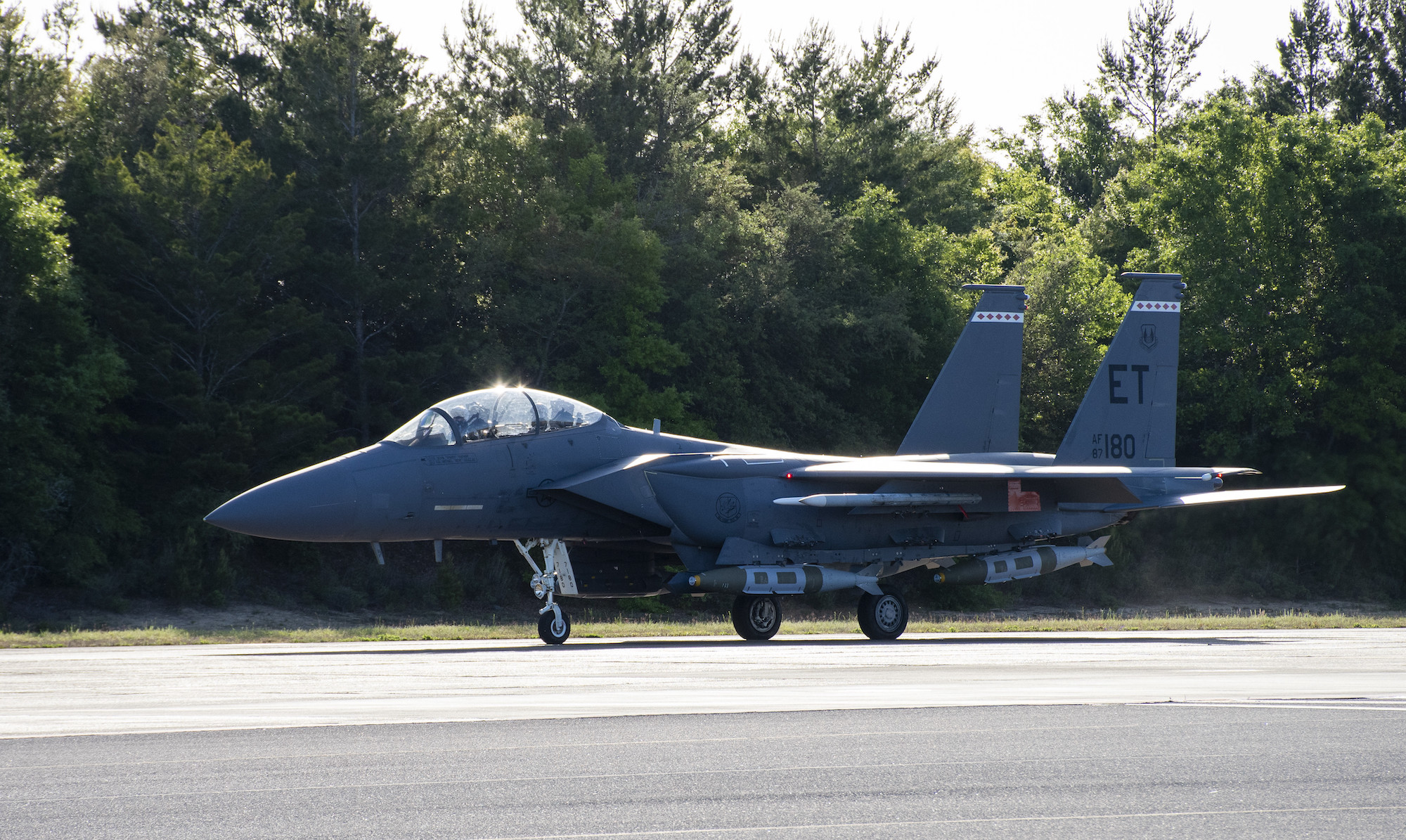

The Air Force is testing a new tool for sinking ships with guided bombs, and this month released additional footage of a successful test of the system from April.
In the video captured from the deck of the derelict ship Courageous, the bomb hits as a plume of water and smoke, with the camera’s angle jolted skyward as the now-halved vessel splits and sinks. The footage, released September 19, offers a more complete picture of an Air Force Research Lab weapons test, which originally took place on April 28. Previous footage showed the ship sinking, from the sky. Now, with the footage from the onboard camera recovered, it is possible to see what would be a sailor’s eye view of the destruction, before the falling bomb permanently condemns them to what would be a long stay in Davy Jone’s locker.
The Air Force Research Laboratory describes its new Quicksink technology as a “low-cost, air-delivered capability for defeating maritime threats.” It is, in practice, a target-tracking system that can attach to existing bombs and bomb guidance systems, letting fighter jets and other planes sink ships from the sky with the accuracy and force typically reserved for seaborne torpedoes.
In the April demonstration, an F-15E Strike Eagle released a roughly 2,000-pound JDAM bomb, hitting and sinking the ship set up as a target in the Gulf of Mexico. (JDAM means “Joint Direct Attack Munition,” and refers to a family of bombs with guidance systems used by both the Air Force and the Navy.) In the first footage released of the test, the target ship can be seen intact, then buckling upward as the bomb hits one-third of the length from the rear of the vessel. The whole of the ship is soon engulfed in a plume of smoke, debris, and blasted water, with the split sections mostly submerged by the time the cloud clears 20 seconds later.
Sinking into history
Sinking ships with attacks from aircraft is a century old idea. In the summer of 1921, the US Navy and Army competed to see which pilots could sink captured German World War I warships used for target practice. (Previously, some of these warships had been used as target practice for battleship guns.) Planes sinking ships became a crucial part of World War II, with some dedicated planes carrying torpedoes, and others flying harrowing dive-bomb attacks to place bombs on ship decks.
Precision guidance systems have improved dramatically since the end of World War II and especially since the 1970s, and anti-ship missiles have benefitted as well.
Current options for sinking surface ships from planes “are the Harpoon AGM-84, Long Range Anti-Ship Missile (LRASM) AGM-158C, and laser guided bombs (GBUs). All achieve functional and mission kills, but sinking a ship may require multiple munitions and all require some level of intelligence knowledge of the ship for mission planning and targeting the critical nodes,” Kirk Herzog, AFRL program manager, told Popular Science via email.
These weapons can prove effective, but long-range flight, navigation, and guidance systems come at a cost. The Harpoon anti-ship missile can be air-, surface-, or submarine-launched, has seen action in Ukraine, and costs over $1 million per missile. The Long Range Anti Ship Missile, a cruise missile built to do what it says on the label, costs over $3.5 million per missile.
Bombs away
Bombs, on the other hand, are relatively cheap, even with guidance systems. In 2020, every JDAM purchased by the Air Force cost about $21,000 apiece. Herzog said that, as a technology demonstration program, there is no target cost per item, but the “objective of the program is to incorporate features, such as Weapon Open System Architecture and open competition, that drive down the overall life cycle cost.” This would make Quicksink a low-cost way for planes to sink ships with JDAMs.
Navy submarines, armed with torpedoes, already perform this patrol function to some degree. The AFRL says that Quicksink “aims to develop a low-cost method of achieving torpedo-like seaworthy kills from the air at a much higher pace and over a much larger area than covered by a lumbering submarine.”
Submarines are an odd direct comparison to aircraft, especially when planes like the Navy’s P-8 Poseidon already carry anti-ship weapons and are used for maritime patrol. What Quicksink offers when used from a stealth fighter, like torpedoes fired from a submarine, is surprise in sinking a vessel. Unlike submarines, which risk revealing themselves in an attack, a stealth plane retains a similar degree of stealth even as it flies away.
The latest video released features a 3D model of the Courageous resting on the seafloor. This 3D model was produced for the Okaloosa County Artificial Reef Office (explore it on their site), and the reefs, which include other wrecks, are promoted by the Office as “excellent sites for fishing, diving, and snorkeling activities.” To make the model, a company called Reef Smart Guides took images captured from an underwater uncrewed vehicle, and then fed it into software that produced a 3D video. “It’s the same technologies used for years to map the ocean bottom, inspect bridges, cables, and other underwater infrastructure,” said Herzog.
One of the videos released by the AFRL shows an animated segment representing a hypothetical future mission where having Quicksink would be important. In that scenario, a navy reconnaissance plane spots a “ship heading to the west coast armed with long range ballistic missile disguised as typical cargo containers,” then dispatches an already-flying F-35 on maritime patrol, which sinks it.
In addition to its effectiveness at guiding a bomb through a target ship, Quicksink is designed as a “Weapon Open Systems Architecture” tool, or one that can easily plug into existing system. Should the US suddenly find itself beset by cargo ships secretly arming and launching ballistic missiles, the ability to easily and rapidly convert existing bombs into guided anti-ship weapons would prove a direct boon for national security.
Watch the ship being sunk, below:

